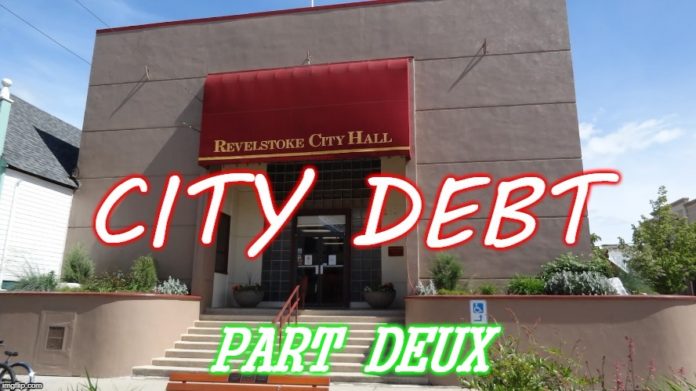In a recent post on the Revelstoke Current, the City’s debt was posted and it was sitting at $15,705,860, however it did not include the Big Eddy Water debt as well as Thomas Brooke because technically, the loan has not been given. The application to the Municipal Finance Authority (MFA) does not go out until the fall of 2018, which means ‘technically’ the City has not acquired that debt, hence a debt total still at $15.7 Million. Once the loan comes through, the total debt will change.
Municipalities borrow through their Regional District, from the Municipal Finance Authority (MFA). The MFA issues debentures, similar to a corporate bond. The proceeds from the issued debentures are given to the municipalities based on their requests. This system is unique in Canada.
Director of Finance, Tania McCabe shared with The Current, “Under the Community Charter, municipalities in the province of B.C. are only allowed to borrow money under a loan authorization bylaw if the financing is undertaken through the applicable regional district and through MFA. .The money borrowed then becomes joint and several amongst all of the municipalities in that regional district. This provides a credit strength that has resulted in the MFA having the lowest municipal borrowing rates in Canada”
The City makes interest payments based on the interest rate and the amount borrowed, as well as a principal payment. However, unlike a consumer loan, the principal payments are not given to the person who bought the debentures, until the end of the term agreed upon. Instead, the principal payments are placed into a sinking fund, which the MFA invests in low risk investments. The interest earned on the sinking fund investments is added to the principal repayments and used to repay the debt.
“We get credit for the investment revenue earned by the sinking fund, every year. We don’t receive it, but it reduces the amount of principal that the City repays.”
There were Equipment Loans taken out in 2017 as it was budgeted that way. These were for the fire truck, dump truck and other equipment purchased in 2017. Moving forward however purchases like this will be funded internally through other reserve funds while the City works to build up the Vehicle and Equipment Reserve Fund.
With a decent amount of dollars in reserve funds why can’t that be used to pay down the debt and become a debt-free community? The rules of borrowing and reserve fund spending mean that is quite simply, not possible.
“Because the borrowing is done using debentures, the City is locked in for the term it borrows for. For instance, when the debt for Clearview Heights was borrowed, it was borrowed for a ten-year term. That’s the commitment and the City can’t repay the debenture sooner. It is not a mortgage or a loan, but the process used gets the City a much better interest rate. Also, reserve funds can only be used for the purposes they are established for.”
Looking at CPR Hill, Big Eddy Water or Thomas Brooke, if the monies were available to spend upfront, there would of course be no debt, but many locals don’t have a combined amount in their savings account to cover such a steep cost which means a loan is necessary. The cost to repay the loan is included on their property tax notice each year.
“You either pay upfront, or you commit to the term. Often, the interest rate through the City is much better than what they could get on their own.”
City Debt - 2017
The Big Eddy Water System has been well underway and is close to completion and that project has been funded thus far with reserve funds as well as grants trickling in. $1.9 million is being financed, and McCabe will apply for that amount in totality in the fall to repay the reserves that were used.
There is a General Reserve Fund, which is funded from the property taxes paid by everyone. There is a separate reserve fund for water for sewer and for the Big Eddy Water. These are funded through water & sewer rates. Clearview Heights and Thomas Brooke water and sewer rates contribute to the appropriate reserve funds that already exist.
“We keep it separate because not everyone is connected to sewer and not everyone is connected to water. The people that pay water and sewer rates need to cover the costs of running the water and sewer systems. That’s one of the reasons why the Internal Admin charges were increased. We looked at the total cost of engineering time, finance time and administration time being spent on water and sewer. It was more than what was being recovered from those funds. They were effectively being subsidized by the general fund and that is not the way it should be.”
The current City debt floats at $15.7 million. As the year continues, the debt will continue to be repaid, ultimately lowering it until the fall when the loan comes through, adding the additional $2.6 million to the overall debt.




